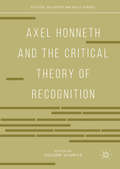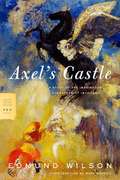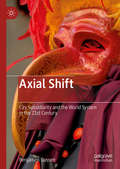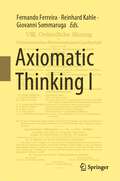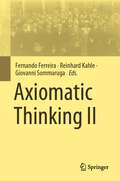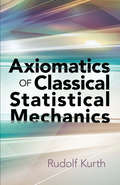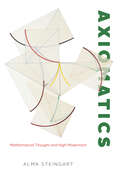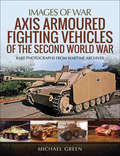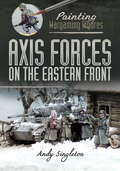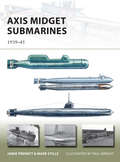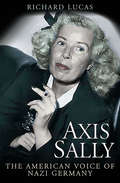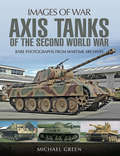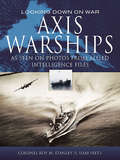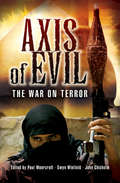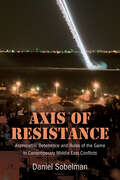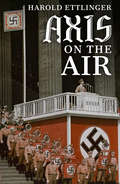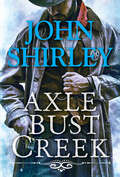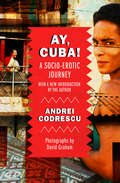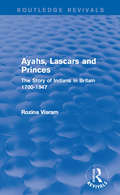- Table View
- List View
Axel Honneth and the Critical Theory of Recognition (Political Philosophy and Public Purpose)
by Volker SchmitzThe critical theory of the Frankfurt School has undergone numerous and at times fundamental changes over the last ninety years. Since the late 1960s, it has been characterized primarily by Jürgen Habermas’s “communicative turn” and a focus on normative foundations. Today, that “second generation” exists side-by-side with a “third generation” represented most prominently by Axel Honneth’s turn toward recognition, ethical life, and the normative reconstruction of social institutions. This volume brings together critical voices on the state and direction of Frankfurt School theory today by examining Honneth’s theory in light of both current challenges and the intellectual and political ambitions that have shaped the tradition from its beginning. United in their strong commitment to critical scholarship, the authors collected here approach Honneth’s work from different backgrounds, employ a wide variety of methodologies, and write in different genres, ranging from the sober scholarly analysis to programmatic and political appeals. The collective aim of these reflections is not to reject Honneth’s theory but to build upon his work and incorporate his themes of recognition and social freedom into a new project of critical theory that can prove adequate to the political and social crises of our time.
Axel's Castle: A Study of the Imaginative Literature of 1870-1930
by Edmund WilsonAxel's Castle was Edmund Wilson's first book of literary criticism--a landmark book that explores the evolution of the French Symbolist movement and considers its influence on six major twentieth-century writers: Yeats, Valery, Eliot, Proust, Joyce, and Stein.
Axial Shift: City Subsidiarity and the World System in the 21st Century
by Benjamen GussenThis book uses historical analysis, constitutional economics, and complexity theory to furnish an account of city subsidiarity as a legal, ethical, political, and economic principle. The book contemplates subsidiarity as a constitutional principle, where cities would benefit from much wider local autonomy. Constitutional economics suggests an optimal limit to jurisdictional footprints (territories). This entails preference for political orders where sovereignty is shared between different cities rather states where capital cities dominate. The introduction of city subsidiarity as a constitutional principle holds the key to economic prosperity in a globalizing world. Moreover, insights from complexity theory suggest subsidiarity is the only effective response to the ‘problem of scale.’ It is a fitness trait that prevents highly complex systems from collapsing. The nation-state is a highly complex system within which cities function as ‘attractors.’ The collapse of such systems would ensue if there were strong coupling between attractors. Such coupling obtains under legal monism. Only subsidiarity can make the eventuality of collapse improbable. The emergent and self-organizing properties of subsidiarity entail a shift in policy emphasis towards cities with a wide margin of autonomy.
Axiomatic Thinking I
by Giovanni Sommaruga Reinhard Kahle Fernando FerreiraIn this two-volume compilation of articles, leading researchers reevaluate the success of Hilbert's axiomatic method, which not only laid the foundations for our understanding of modern mathematics, but also found applications in physics, computer science and elsewhere.The title takes its name from David Hilbert's seminal talk Axiomatisches Denken, given at a meeting of the Swiss Mathematical Society in Zurich in 1917. This marked the beginning of Hilbert's return to his foundational studies, which ultimately resulted in the establishment of proof theory as a new branch in the emerging field of mathematical logic. Hilbert also used the opportunity to bring Paul Bernays back to Göttingen as his main collaborator in foundational studies in the years to come.The contributions are addressed to mathematical and philosophical logicians, but also to philosophers of science as well as physicists and computer scientists with an interest in foundations.Chapter 8 is available open access under a Creative Commons Attribution 4.0 International License via link.springer.com.
Axiomatic Thinking II
by Giovanni Sommaruga Reinhard Kahle Fernando FerreiraIn this two-volume compilation of articles, leading researchers reevaluate the success of Hilbert's axiomatic method, which not only laid the foundations for our understanding of modern mathematics, but also found applications in physics, computer science and elsewhere.The title takes its name from David Hilbert's seminal talk Axiomatisches Denken, given at a meeting of the Swiss Mathematical Society in Zurich in 1917. This marked the beginning of Hilbert's return to his foundational studies, which ultimately resulted in the establishment of proof theory as a new branch in the emerging field of mathematical logic. Hilbert also used the opportunity to bring Paul Bernays back to Göttingen as his main collaborator in foundational studies in the years to come.The contributions are addressed to mathematical and philosophical logicians, but also to philosophers of science as well as physicists and computer scientists with an interest in foundations.
Axiomatics of Classical Statistical Mechanics (Dover Books on Physics #Volume 11)
by Rudolf KurthRequiring only familiarity with elements of calculus and analytical geometry, this monograph constructs classical statistical mechanics as a deductive system, based on equations of motion and basic postulates of probability. 1960 edition.
Axiomatics: Mathematical Thought and High Modernism
by Alma SteingartThe first history of postwar mathematics, offering a new interpretation of the rise of abstraction and axiomatics in the twentieth century. Why did abstraction dominate American art, social science, and natural science in the mid-twentieth century? Why, despite opposition, did abstraction and theoretical knowledge flourish across a diverse set of intellectual pursuits during the Cold War? In recovering the centrality of abstraction across a range of modernist projects in the United States, Alma Steingart brings mathematics back into the conversation about midcentury American intellectual thought. The expansion of mathematics in the aftermath of World War II, she demonstrates, was characterized by two opposing tendencies: research in pure mathematics became increasingly abstract and rarified, while research in applied mathematics and mathematical applications grew in prominence as new fields like operations research and game theory brought mathematical knowledge to bear on more domains of knowledge. Both were predicated on the same abstractionist conception of mathematics and were rooted in the same approach: modern axiomatics. For American mathematicians, the humanities and the sciences did not compete with one another, but instead were two complementary sides of the same epistemological commitment. Steingart further reveals how this mathematical epistemology influenced the sciences and humanities, particularly the postwar social sciences. As mathematics changed, so did the meaning of mathematization. Axiomatics focuses on American mathematicians during a transformative time, following a series of controversies among mathematicians about the nature of mathematics as a field of study and as a body of knowledge. The ensuing debates offer a window onto the postwar development of mathematics band Cold War epistemology writ large. As Steingart’s history ably demonstrates, mathematics is the social activity in which styles of truth—here, abstraction—become synonymous with ways of knowing.
Axiomatics: Mathematical Thought and High Modernism
by Alma SteingartThe first history of postwar mathematics, offering a new interpretation of the rise of abstraction and axiomatics in the twentieth century. Why did abstraction dominate American art, social science, and natural science in the mid-twentieth century? Why, despite opposition, did abstraction and theoretical knowledge flourish across a diverse set of intellectual pursuits during the Cold War? In recovering the centrality of abstraction across a range of modernist projects in the United States, Alma Steingart brings mathematics back into the conversation about midcentury American intellectual thought. The expansion of mathematics in the aftermath of World War II, she demonstrates, was characterized by two opposing tendencies: research in pure mathematics became increasingly abstract and rarified, while research in applied mathematics and mathematical applications grew in prominence as new fields like operations research and game theory brought mathematical knowledge to bear on more domains of knowledge. Both were predicated on the same abstractionist conception of mathematics and were rooted in the same approach: modern axiomatics. For American mathematicians, the humanities and the sciences did not compete with one another, but instead were two complementary sides of the same epistemological commitment. Steingart further reveals how this mathematical epistemology influenced the sciences and humanities, particularly the postwar social sciences. As mathematics changed, so did the meaning of mathematization. Axiomatics focuses on American mathematicians during a transformative time, following a series of controversies among mathematicians about the nature of mathematics as a field of study and as a body of knowledge. The ensuing debates offer a window onto the postwar development of mathematics band Cold War epistemology writ large. As Steingart’s history ably demonstrates, mathematics is the social activity in which styles of truth—here, abstraction—become synonymous with ways of knowing.
Axiomatics: Mathematical Thought and High Modernism
by Alma SteingartThe first history of postwar mathematics, offering a new interpretation of the rise of abstraction and axiomatics in the twentieth century. Why did abstraction dominate American art, social science, and natural science in the mid-twentieth century? Why, despite opposition, did abstraction and theoretical knowledge flourish across a diverse set of intellectual pursuits during the Cold War? In recovering the centrality of abstraction across a range of modernist projects in the United States, Alma Steingart brings mathematics back into the conversation about midcentury American intellectual thought. The expansion of mathematics in the aftermath of World War II, she demonstrates, was characterized by two opposing tendencies: research in pure mathematics became increasingly abstract and rarified, while research in applied mathematics and mathematical applications grew in prominence as new fields like operations research and game theory brought mathematical knowledge to bear on more domains of knowledge. Both were predicated on the same abstractionist conception of mathematics and were rooted in the same approach: modern axiomatics. For American mathematicians, the humanities and the sciences did not compete with one another, but instead were two complementary sides of the same epistemological commitment. Steingart further reveals how this mathematical epistemology influenced the sciences and humanities, particularly the postwar social sciences. As mathematics changed, so did the meaning of mathematization. Axiomatics focuses on American mathematicians during a transformative time, following a series of controversies among mathematicians about the nature of mathematics as a field of study and as a body of knowledge. The ensuing debates offer a window onto the postwar development of mathematics band Cold War epistemology writ large. As Steingart’s history ably demonstrates, mathematics is the social activity in which styles of truth—here, abstraction—become synonymous with ways of knowing.
Axioms of Kwame Nkrumah
by Kwame NkrumahA listing of axioms taken from various speeches by the famous African leader.
Axis Armoured Fighting Vehicles of the Second World War (Images of War)
by Michael GreenDuring the Second World War the Axis powers, most prolifically the Germans, deployed a vast array of armored fighting vehicles to support their tanks and infantry. These included tank destroyers, reconnaissance vehicles, flame-thrower vehicles, and self-propelled artillery pieces. Armored tank destroyers, such as the Marder series, the Nashorn, Jagdpanther, Jagdtiger and the turretless German Stu III series (based on the Panzer III medium tank), helped the Nazis overcome their shortage of tanks. Copying the Stu III series the Italians created the turretless Semovente da 75/18 assault gun and the Hungarians the turretless Zrinyi. In the role of self-propelled artillery the German fielded the Hummel, the Wespe and the Grille while the Brummbar and the Sturmtiger performed in the dedicated assault gun role. For armored reconnaissance German industry came up with a series of capable armored cars; examples were the eight-wheel Puma and the full-tracked Luchs reconnaissance tank. The Italians developed the impressive four-wheel Autoblinda armored cars. Specialized antiaircraft tanks such the Mobelwagen, Wirbelwind and the Ostwind gave some protection against the ever more powerful Allied air forces. This fine book covers all these variants and many more besides in words and rare images and will delight readers, collectors, model-makers and war-gamers.
Axis Armoured Fighting Vehicles of the Second World War: Rare Photographs From Wartime Archives (Images of War)
by Michael GreenDuring the Second World War the Axis powers, most prolifically the Germans, deployed a vast array of armored fighting vehicles to support their tanks and infantry. These included tank destroyers, reconnaissance vehicles, flame-thrower vehicles, and self-propelled artillery pieces. Armored tank destroyers, such as the Marder series, the Nashorn, Jagdpanther, Jagdtiger and the turretless German Stu III series (based on the Panzer III medium tank), helped the Nazis overcome their shortage of tanks. Copying the Stu III series the Italians created the turretless Semovente da 75/18 assault gun and the Hungarians the turretless Zrinyi. In the role of self-propelled artillery the German fielded the Hummel, the Wespe and the Grille while the Brummbar and the Sturmtiger performed in the dedicated assault gun role. For armored reconnaissance German industry came up with a series of capable armored cars; examples were the eight-wheel Puma and the full-tracked Luchs reconnaissance tank. The Italians developed the impressive four-wheel Autoblinda armored cars. Specialized antiaircraft tanks such the Mobelwagen, Wirbelwind and the Ostwind gave some protection against the ever more powerful Allied air forces. This fine book covers all these variants and many more besides in words and rare images and will delight readers, collectors, model-makers and war-gamers.
Axis Forces on the Eastern Front (Painting Wargaming Figures)
by Andy SingletonFull of practical tips and useful advice on materials and techniques for the beginner.Andy Singleton has been modeling and painting most of his life and has been a professional commission figure painter for some years now. Here he shares his experience and tips of the trade for painting Axis forces on WW2’s Eastern Front: Germans, Romanians, Hungarians and Italians and Finns. Each of the chapters is broken into step by step guides explaining the steps and colors required to paint the various uniforms used. The emphasis is on quickly achievable results and practical advice that is applicable to painting units or whole armies for wargaming purposes in a reasonable time frame. The techniques described are designed to easily be adaptable to figures of all sizes. Andy’s clear, step-by-step guidance is primarily designed for those new to historical gaming, and takes the reader through the process from the initial preparation and assembly of the figure, to finishing and basing.
Axis Midget Submarines
by Paul Wright Mark StilleDuring World War II, Germany, Japan, and Italy built approximately 2,000 small, inherently stealthy, naval craft to perform special operations and conventional naval missions. Much more numerous and more technically advanced than their Allied counterparts, they saw service worldwide, operating in the Pacific, Mediterranean, Black Sea, Indian Ocean, North Sea, and the English channel. Manned by courageous crews, these vessels made daring attacks on Allied ships in heavily protected anchorages using torpedoes and mines. Most notable were attacks against Gibraltar - launched from an Italian cargo vessel interred in nearby neutral Spain that had been converted into a clandestine support base and equipped with an underwater hatch - and Pearl Harbor. They were used against shipping in coastal waters and, near the end of the war, in desperate attempts to offset their opponents' overwhelming naval superiority during the US advance across the Pacific and the Allied amphibious landings in France and Italy. This volume will detail the history, weapons, and operations of German, Japanese, and Italian midget submarines.
Axis Sally: The American Voice of Nazi Germany
by Richard LucasA &“fascinating, well-researched account&” of Mildred Gillars, the failed actress who turned on her country and became a Nazi propagandist during WWII (Publishers Weekly). One of the most notorious Americans of the twentieth century was a failed Broadway actress turned radio announcer named Mildred Gillars (1900–1988), better known to American GIs as &“Axis Sally.&” Despite the richness of her life story, there has never been a full-length biography of the ambitious, star-struck Ohio girl who evolved into a reviled disseminator of Nazi propaganda. At the outbreak of war in September 1939, Gillars had been living in Germany for five years. Hoping to marry, she chose to remain in the Nazi-run state even as the last Americans departed for home. In 1940, she was hired by the German overseas radio, where she evolved from a simple disc jockey and announcer to a master propagandist. Under the tutelage of her married lover, Max Otto Koischwitz, Gillars became the personification of Nazi propaganda to the American GI. Spicing her broadcasts with music, Gillars&’s used her soothing voice to taunt Allied troops about the supposed infidelities of their wives and girlfriends back home, as well as the horrible deaths they were likely to meet on the battlefield. Supported by German military intelligence, she was able to convey personal greetings to individual US units, creating an eerie foreboding among troops who realized the Germans knew who and where they were. After broadcasting for Berlin up to the very end of the war, Gillars tried but failed to pose as a refugee, and was captured by US authorities. Her 1949 trial for treason captured the attention and raw emotion of a nation fresh from the horrors of the Second World War. Gillars&’s twelve-year imprisonment and life on parole, including a stay in a convent, is a remarkable story of a woman who attempts to rebuild her life in the country she betrayed.
Axis Tanks of the Second World War (Images of War)
by Michael GreenThis pictorial history presents an in-depth study of the various tanks built and deployed by the Axis Alliance during WWII. Though Nazi Panzer tanks have become a ubiquitous symbol of Axis Alliance combat, the Japanese Army had more tanks than Germany in 1938. These included the Type 95 light tank and the Type 89 and 97 medium tanks. Other Axis powers, including Italy, Romania and Hungary also built their own tanks. The latter was responsible for the Toldi and Turan light tank series. In this informative collection of wartime photographs, military expert Michael Green discusses how the Axis powers drew on British and French tank designs in the period leading up to the Second World War. The Carden-Loyd tankette suspension was used as a model for the Panzer 1 series as well as the light Italian and Japanese tanks. German engineering talent then produced the ingenious designs of the Panzer II, III and IV series and, later in the War, the Panther Medium and Tiger heavy tanks.
Axis Warplane Survivors
by Harold A. SkaarupAxis Warplane Survivors - A guidebook to the preserved Military Aircraft of the Second World War Tripartite Pact of Germany, Italy, and Japan, joined by Hungary, Romania, Slovakia, Bulgaria, and Yugoslavia; the co-belligerent states of Thailand, Finland, San Marino and Iraq; and the occupied states of Albania, Belarus, Croatia, Vichy France, Greece, Ljubljana, Macedonia, Monaco, Montenegro, Norway, Cambodia, China, India, Laos, Manchukuo, Mengjiang, the Philippines and Vietnam.
Axis Warships: As Seen on Photos from Allied Intelligence Files (Looking Down on War)
by Colonel Roy M. Stanley IIFor his latest book Colonel Roy Stanley presents aerial photographs of the German and Italian fleets that were selected as important six decades ago and have long lain dormant, unindexed and unexplained. Extensive use of aerial and other Intelligence imagery from long retired files would be enough to make this book a must for those intrigued by World War II intelligence and naval history. But it is the author's commentary that makes this work truly unique, thanks to his aerial photo interpretation experience, ability to provide Intelligence analysis, and academic background. Meticulously researched for ship identification, the eye of an experienced PI sees things others might miss, and the author tells us what he sees. Some of these photos may have appeared in contemporary documents but never with the insight presented in this book. We see warships under attack, at sea and in harbor as captured by photo reconnaissance. Analysis of selective enlargements adds to the understanding. Even the most devout follower of warships will learn something.
Axis of Evil: The War on Terror
by John Chisholm Gwyn Winfield Paul L. MoorcraftBy means of interviews with, and contributions from, prominent international figures, Axis of Freedom examines the dramatic world events which unfolded from 11 September 2001 to the end of occupation of Iraq in the summer of 2004. Many books have been written on the war on terror, but none include the personal views and opinions of so many top military and political leaders. The contributions are linked by a series of essays to form a compelling narrative of the new way of war. In their own words the key decision-makers such as Donald Rumsfeld, Richard Perle and Geoff Hoon talk about the strategic dilemmas. The military implementation of the political decisions are discussed by leaders such as the head of the US Air Force, the former British Chief of Defence Staff, Lord Guthrie, and the Royal Navy's First Sea Lord. Highly charged critiques by George Galloway MP are also included, as well as Iraq's deputy prime minister, Tariq Aziz, who was interviewed on the eve of the war. Senior foreign correspondents such as Channel Four's Lindsey Hilsum add their own frontline assessments. In addition, leading academic analysts such as Dr Paul Cornish put the political and military debates in context.
Axis of Resistance: Asymmetric Deterrence and Rules of the Game in Contemporary Middle East Conflicts
by Daniel SobelmanFrom the conflict between the United States and the Iranian-backed militias in Iraq and Syria to the recent Israel-Hamas war in the Gaza Strip, events in today's Middle East reflect the emergence of what has come to be known as an Iran-led "axis of resistance." A geopolitical network of state- and nonstate actors seeking to promote a new regional order, the "axis" primarily includes the Lebanese Hezbollah, Hamas in the Gaza Strip, Yemen’s Houthi rebels, Syria, and multiple Iran-supported Shiite militias in Iraq. Drawing on qualitative in-depth research in Hebrew and Arabic, and on exclusive interviews with senior Israeli officials, Axis of Resistance offers the first comprehensive analysis of the evolution of the "axis" and its application of a distinct strategic approach to asymmetrical conflicts—that of “resistance.” Author Daniel Sobelman shows that the various "resistance" forces in the region have pursued an analogous asymmetrical deterrent strategy whose origins trace back to the Israel-Hezbollah conflict in southern Lebanon, whereby the weaker actor attempts to subject the stronger state to limiting "rules of the game."
Axis on the Air
by Harold L. EttlingerThe Axis on the Air, first published in 1943, is a fascinating look at the use of radio for propaganda purposes by the Nazis, Japanese, and Italians during World War II. Author Harold Ettlinger, a columnist for the Chicago Sun, provides insight and numerous examples of Nazi Propaganda Minister Goebbels, famous traitors such as “Lord Haw Haw,” Jane Anderson, and Ezra Pound, and Axis broadcasts to its own citizens as well as efforts to create unrest and lower morale in England and the United States. The book also examines Allied radio services such as the BBC and Voice of America, plus radio stations in some of the smaller European countries such as Sweden and Finland.A vivid, authentic description of how the Axis, led by Goebbels, has used the radio as a weapon for subjugating its enemies.
Axle Bust Creek (A Cleve Trewe Western #1)
by John ShirleyThe first book in a thrilling new western series from John Shirley, the acclaimed co-author of the Sundown Riders western series. GOLD FEVER. BLOOD FEVER. From the battlefield of Shiloh to the prisoner camp at Slocum, former Union soldier Cleveland Trewe has seen more than enough carnage for one lifetime. Now that the war is over he&’s found work as a peacekeeper and prospector—the perfect set of survival skills for a town like Axle Bust, Nevada, a place seething with danger. Cleve&’s uncle staked a claim in Axle Bust only to lose it to a murderous con-man partnered with Duncan Conroy, owner of the Golden Fleece Mine and a man determined to build an empire by means fair and foul. The only person keeping Conroy in check is his sister Berenice, a freethinker whose scientific education benefits the family interests—even while catching Cleve&’s eye. To reclaim his uncle&’s mine, and bring justice to a town under tyranny, Cleve finds himself turning the streets into a bullet-riddled battlefield. Conroy is about to learn there just isn&’t room for both men in a town like Axle Bust. Praise for John Shirley&“Gritty realism, thrilling—this is a good one.&” —Lincoln Journal Star on Wyatt in Wichita&“One of our best and most singular writers. A powerhouse of ideas and imagery.&” —William Gibson
Ay, Cuba!: A Socio-Erotic Journey
by Andrei CodrescuA rare and intimate glimpse at life in Cuba at the end of the twentieth century For NPR commentator Andrei Codrescu, reporting from Cuba on the eve of Pope John Paul II's 1998 visit was an opportunity to understand the realities of life in a country that has long been the subject of stereotypes and misconceptions. Following the collapse of the Soviet Union, Cuba was the last place to witness a "laboratory of pre-post-communism," as it toed the line between its socialist past and its uncertain future. On the streets of Havana and the beaches of Santiago de Cuba, Codrescu met people from all walks of life--from prostitutes and fortunetellers to bureaucrats and writers--eager to share their stories. Uncensored and compassionate, his interviews reveal a world where destruction and beauty, poverty and pride exist side by side. Traveling with photographer David Graham, whose powerful images illustrate the energy pulsing through everyday life in Cuba, Codrescu captures the humanity of a nation that is lost when it's reduced to a political symbol. With the United States resuming relations with Cuba for the first time in decades, Ay,Cuba! is more relevant now than ever before.
Ay, pecados: Historias que enamoran
by Cristina Bajo Gloria V. Casañas Mariana GuarinoniEn estos cuentos se desatan pasiones ocultas, se revelan secretos inconfesables y los personajes se entregan a hacer realidad sus deseos más profundos. ¿Cuánto estamos dispuestos a arriesgar por amor? ¿Hasta dónde se puede llegar por celos? ¿Se perdona una traición? Una mujer casada sucumbe al deseo y no quiere que amanezca. Dos compañeros de trabajo se miran de verdad por primera vez. Un hombre perfecto esconde un pasado aterrador. Una segunda oportunidad, una pasión inconfesable, una traición que deja heridas, un matrimonio roto. Los relatos que integran este libro están atravesados por los pecados del amor, tan subjetivos y únicos como cada historia que se construye de a dos: la venganza, la renuncia, la pasión, el desenfreno, la infidelidad, la codicia, la mentira, el engaño. Ay, pecados reúne catorce cuentos de todas las épocas escritos por las autoras románticas más talentosas: Cristina Bajo, Gloria V. Casañas, Fernanda Pérez, Gabriela Exilart, Gabriela Margall, Camucha Escobar, Graciela Ramos, Magda Tagtachian, Mariana Guarinoni, Carlota del Campo, María Border, Mirta Pérez Rey, Anabella Franco y Andrea Milano.
Ayahs, Lascars and Princes: The Story of Indians in Britain 1700-1947 (Routledge Revivals)
by Rozina VisramPeople from the Indian sub-continent have been in Britain since the end of the seventeenth century. The presence of princes and maharajahs is well documented but this book, first published in 1986, was the first account of the ordinary people in Britain. This book will be of interest to students of history.
